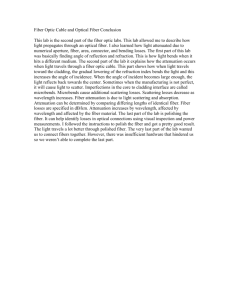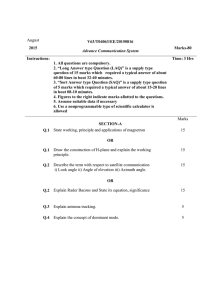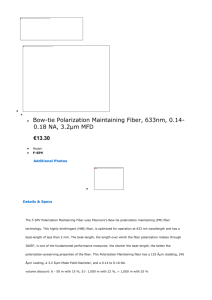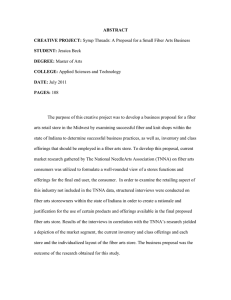Document 12643333
advertisement
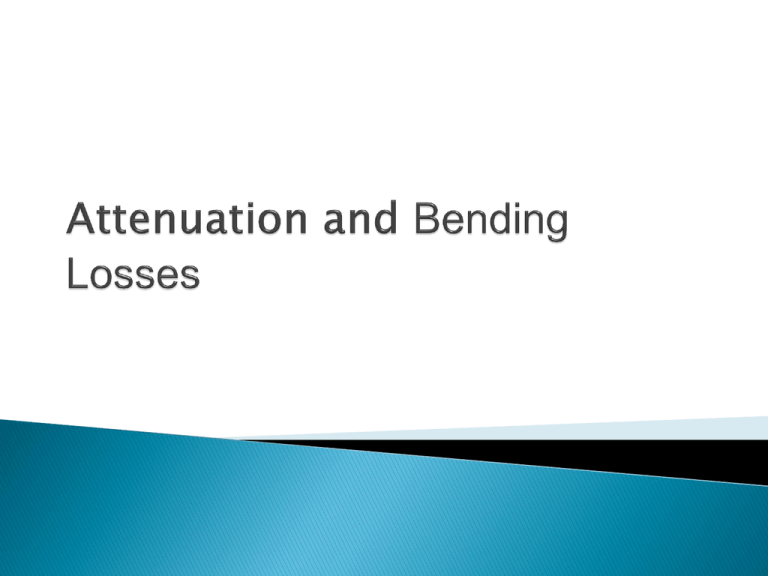
Attenuation in a fiber optic signal is the loss of optical power as the signal travels through the fiber. Attenuation is caused by the fact that no manufacturing process can produce a perfectly pure fiber. Either by accident or by design, the fiber will always have some characteristic that attenuates the signal passing through it. The wavelength of the light passing through the fiber also affects attenuation. Attenuation decreases as wavelength increases There are certain wavelengths that are more easily absorbed in plastic and silica fibers than others such 730, 950, 1250, and 1380 nm. These range are considered high-loss regions. So, 850 nm, 1300 nm, and 1550 nm in silica fiber and in the visible range of 650 nm for plastic are establishing standard operating wavelengths. The effect on a signal due to attenuation increases with the length of the fiber. Attenuation behaves differently from Dispersion Where, its effects accumulate Whereas, dispersion is determined by factors within the fiber and the signal’s wavelength and spectral width There are two types of attenuation: Absorption and Scattering Absorption The amount of absorption depends on the type of material and the wavelength of the light passing through it. The wavelengths that do not pass through are mostly absorbed by impurities that have been placed in, or coated on, the lens material (such as sunglasses). In an optical fiber, Absorption occurs when impurities such as water or ions of materials such as copper or chromium absorb certain wavelengths By keeping these impurities as low as possible, manufacturers can produce fibers with a minimum of attenuation Scattering Scattering is caused by atomic structures and particles in the fiber redirecting light that hits them. This phenomenon is described by the British physicist Lord Rayleigh. Rayleigh scattering is also the answer to the age-old question “Why is the sky blue?” The blue that we see is actually the more prevalent blue wavelengths of light from the sun being scattered by particles in the atmosphere. As the sun moves toward the horizon and the light must pass through more of the atmosphere, the scattering increases to the point where the blue light is almost completely attenuated, leaving the red wavelengths, which are less affected by the scattering. Rayleigh scattering depends on the relationship between wavelength and the size of the structures in the fiber. Scattering increases as the wavelength of the light approaches the size of the structures, which means that as the wavelength decreases, it is more likely to be scattered. This is one of the main reasons that infrared wavelengths are used in fiber optics The wavelengths of infrared are less subject to scattering than visible wavelengths. Total Attenuation Total attenuation is the combination of the effects of absorption and scattering in a fiber. Many of a fiber’s characteristics are determined by the relationship between the core and the cladding. The numerical aperture (NA) expresses the lightgathering ability of the fiber. The NA is a dimensionless number, meaning that it is to be used as a variable in determining other characteristics of the fiber, or as a means of comparing two fibers. [(𝒏𝟏 )𝟐 − (𝒏𝟐 )𝟐 ] 𝑵𝑨 = where 𝒏𝟏 is the refractive index of the core and 𝒏𝟐 is the refractive index of the cladding In order for light to be contained within a multimode fiber it must stay above the critical angle, or the angle at which it reflects off of the boundary between the core and the cladding, rather than penetrating the boundary and refracting through the cladding. In order to maintain the critical angle, light must enter within a specified range called the cone of acceptance also known as the acceptance angle This region is defined by a cone extending outside the fiber core. Light entering the core from outside of the cone will either miss the core or enter at an angle that will allow it to pass through the boundary with the cladding and be lost. The cone of acceptance is determined using the numerical aperture: NA = sin where is 1/2 of the angle measuring the cone of acceptance. Another useful term is the maximum coupling angle. The acceptance angle is also used to determine how light emerges from a fiber. The light that comes out of a fiber end is the light that has not been absorbed or lost in the cladding The exception of a small percentage of light that has propagated in the boundary between the core and the cladding, what emerges is coming out at an angle equal to or greater than the critical The types of bending we will look at are microbends and macrobends Microbend Microbends are small distortions of the boundary layer between the core and cladding caused by crushing or pressure. Microbends change the angle of incidence within the fiber Changing the angle of incidence forces high-order light rays to reflect at angles that prevent further reflection, causing them to be lost in the cladding and absorbed Macrobends Macrobends occur when the fiber is bent around a radius that can be measured in centimeters. These tight radii change the angle of incidence within the fiber, causing some of the light rays to reflect outside of the fiber and, as with microbending, be lost in the cladding and absorbed.



